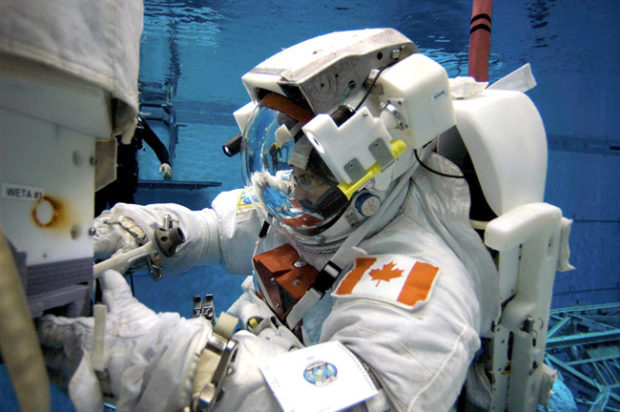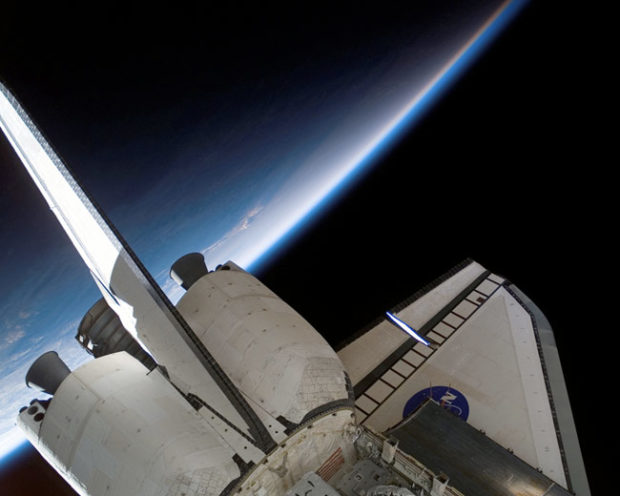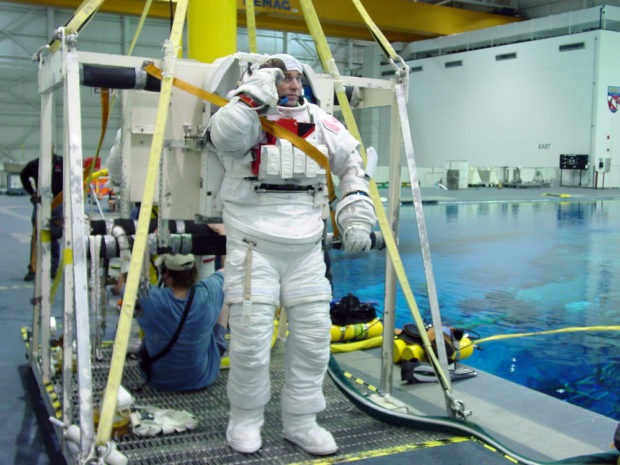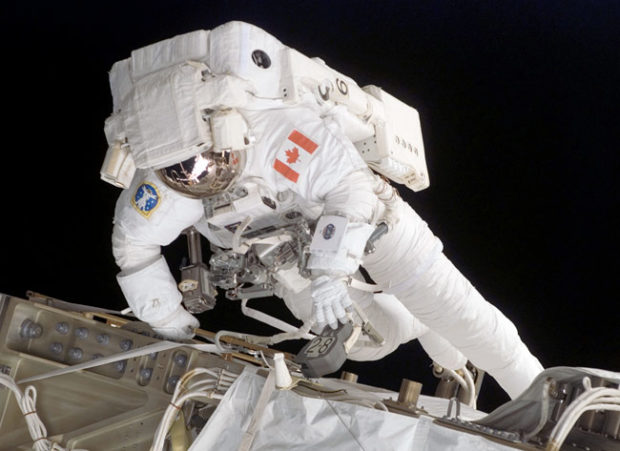Skywalker – Canada’s Diving Astronaut
Dave Williams was just a kid when he made a farsighted commitment that eventually saw him blast off for the international space station. And his boyhood dive training and years of experience in the sport backstop his record setting spacewalks.
Text by Dave Williams

My helmet lights reflect on the shiny white interior of the airlock as I move toward the open hatch and the infinite black void of space. Rick is already outside and out of sight although I can hear his reassuring voice. “Dave, I’m located on the aft handrail, you’re go for egress.” With vigilance I centre myself in the hatch, avoiding spacesuit contact with its edges, and assume the egress position. Legs out first, torso next, I emerge into the enveloping darkness. With my right hand I reach out and grab the forward portion of the airlock handrail and turn to face Rick, our helmet lights illuminating one another. Looking around, we see nothing of the planet 185 miles (300km) beneath us that we’re orbiting every 90 minutes at five miles (8km) per second… so much for the incredible beauty of Earth as seen during a spacewalk!

That first time for us out the hatch took place during a night pass. The absence of a compelling view of our home planet helped us focus on the tasks ahead. Slowly, we advanced along the handrails heading for the starboard side of the space station to install a critical element of the truss – the long central backbone of the structure that’s home to the solar arrays and a number of other space station systems.
NEEMO-9
Despite the intense focus needed during that ‘translation’, the surrounding blackness took me back to a dawn dive I made during NEEMO-9, a NASA mission to the Aquarius undersea research habitat. In April 2006, surgeon Tim Broderick, NASA astronauts Ron Garan, Nicole Stott and I were underwater on an 18-day mission to study complex telehealth technologies that might be needed to send humans on space missions that would extend the time distance constant of space exploration – sending humans farther into space and keeping them there longer.
Earlier in the mission we had been evaluating telerobotic surgery. On that occasion the technology had allowed Dr. Mehran Anvari, a surgeon 1,600 miles (2,500km) away at St. Joseph’s Hospital in Hamilton, Ontario, to control the movement of the surgical robot in our habitat 60 feet (18m) under the surface of the ocean off south Florida.
The morning of the dawn dive we donned our twin 100 cubic-foot cylinders in the cold darkness of the wet porch. As we slowly swam from the habitat to the first transect – ropes used to navigate the reef adjacent to the habitat – our underwater lights illuminated the murky depths below us. The bioluminescent plankton around us were like shimmering stars as we headed to the bottom to watch the sun rise through the water column.
Boyhood Dreams
I had dreamt about becoming an astronaut from the time I watched Alan Shepard launch on the first American sub-orbital flight May 5th, 1961. Eleven days before my seventh birthday I firmly committed to myself the goal of flying in space. My youthful enthusiasm overlooked certain realities. Though Canada was the third country to launch satellites into space, back then the chance of becoming a Canadian astronaut was essentially non-existent. Still, I continued to follow the space program with great enthusiasm and it occurred to me that if I couldn’t explore outer space, perhaps I could explore the undersea world and live onboard an undersea habitat. Ironically, it was three years after my first space flight that I became Canada’s first astronaut-aquanaut, participating in the 7-day NEEMO 1 mission.

My heroes of the 1960s included the Mercury, Gemini and Apollo astronauts, Jacques Cousteau and Canadian underwater explorers Joe MacInnis and Phil Nuytten. I began looking forward to Sunday bath nights, when I donned my first facemask and snorkel to explore the six-inch depths of the tub. With images of the Conshelf habitat vividly in mind, I asked my parents if I could start SCUBA diving when I turned 12. After much discussion and my earnest agreement to pass all of the written and practical tests, they consented, to my delight. I enrolled in NAUI basic diver training in January 1967. Nightly covert missions followed beneath my bed sheets. Flashlight in hand, I immersed myself in the U.S. Navy Diving Manual until dawn’s early light. And it paid off. I became certified NAUI diver 4381 soon after my 13th birthday. Numerous open water dives followed in Maine, Florida, the Caribbean and Mediterranean. The excitement of exploring the undersea world continued and ultimately led to my certification as a NAUI Assistant Instructor and finally NAUI Instructor when I was a student at McGill University.
Galaxy Quest
Through this time my quest for space exploration did not diminish and took on a whole new meaning July 20th, 1969, as I watched the Apollo 11 lunar landing. This event reawakened my dream to transition from diving to spacewalking. Little did I realize that my passion for underwater exploration would become a key consideration in being selected to conduct three record setting spacewalks to build and service the International Space Station. The skills I acquired as a diver, the ability to gracefully navigate in a three dimensional world, have long been recognized as critical in training for spacewalks.
Back on the Space Station, Rick and I continue our slow, patient, hand over hand advance toward the starboard end, more than 160 feet (50m) from the safety of the airlock. Halfway to our destination I pause to switch from one safety tether to another, focusing hard. Our lead training instructor, Paul Boehm, repeatedly emphasized the crucial attribute of ‘focus’ when spacewalking – for times just like this. If I mess up the procedure, I could become detached and, as we say in the space program, float freely with “the rest of my life” to use the spacesuit jetpack to fly back to the space station. As I perform the tether swap in the cold vacuum of this hostile environment, I feel myself getting warmer. From inside the station our spacewalking choreographer, Tracy, calls on the air-to-ground frequency to remind us that the sun is rising and for us to turn off our helmet lights and glove heaters. I pause to complete these tasks and – stealing a moment for myself – watch as the dawn colours our world below, bringing it to life. It’s an image imprinted in my memory.
Rick and I are ahead on the timeline as we arrive at the worksite on the fourth element of the starboard truss. We set-up our tools and position ourselves for the carefully choreographed robotic maneuver in which our pilot Charlie (Scorch) Hobaugh will guide the 4,000-pound (1800kg) S5 truss segment into position for us to bolt in place and to mate the electrical connectors. Like seasoned dive buddies, Tracy, Scorch, Rick and I work in seamless coordination. This ability is a tribute to the excellence of our trainers and it is this teamwork that stands as one of my greatest memories of being in space.
Dawn Dive
Teamwork is fundamental to exploration. As Commander of the NEEMO-9 mission I was responsible for all aspects of its overall success and crew safety. The undersea environment where I first learned about exploration is also where NASA trains crews for long duration duty aboard the International Space Station. Tim, Ron, Nicole and I spent many hours together preparing for our 18-day Aquarius assignment with no less diligence than we’d bring to a Space Shuttle or Space Station mission. Building on the results of earlier NEEMO operations, our science goals reflected a unique blend of research experiments performed inside the habitat and dive exploration research during simulated spacewalks on the ocean floor. We exploited our ability to switch from neutral buoyancy – similar to spacewalking on the Space Station – to adding weights to mimic the one-sixth gravitational environment of the lunar surface.
For our dawn dive we were neutrally buoyant, gliding with little effort over the reef, in search of a sandy patch from which to observe the sunrise through the water column. After a quick check to ensure everyone was okay, I signalled the team to adjust buoyancy and drop gradually to the bottom. As my breathing slowed I was able to hear the sounds of the ocean, the myriad undersea creatures surrounding me in the pre-dawn night. And in contrast to the black void of space, the luminescence of the plankton all around, was a reminder of its earthly, organic nature.

Then the first hint of the sun’s rays penetrated the darkness above turning my liquid world a dark blue that continuously lightened as the sun rose above the horizon. In the crystal clear water the rays of sun danced around us, casting shimmering shadows on the pristine white sand. But it was time to get back to work. We returned to the reef transect that led us back to the habitat. There, we swapped our SCUBA gear for the Superlite-17 dive helmets employed on our simulated spacewalks. On that particular day our challenge was to evaluate the centre of gravity of the new prototype planetary exploration suits that may be used on missions back to the Moon or to Mars. And as I donned my helmet that day I remember thinking that it was fitting my quest to become an astronaut began underwater and that it had brought me back underwater for the purpose of furthering the goals of space exploration.
Weightless Worlds
My second spaceflight brought many challenges: the complexity of the mission objectives and preparation for the three spacewalks. For me, this involved a unique blend of physical training, mental conditioning and working with the crew to choreograph an efficient operational plan that would allow us to achieve our objectives. Preparation is critical – we train like we fly and fly like we train. When we exit the hatch into the harsh vacuum of space, where temperature fluctuations range over some 260oF (125oC), we need the skills to deal with whatever happens.
In retrospect, I can say that all of my early diving experience helped prepare me for NASA’s underwater spacewalk training and the actual spacewalks on the Station. The stabilizing force of water is a major difference between the two environments. Training underwater for a spacewalk it’s hard to get moving against the resistance of the dense liquid, and easy to stop. During a spacewalk it’s easy to get going and hard to stop. As it happened, these lessons proved valuable executing the complex maneuvers of our second spacewalk to replace a failed gyroscope, in which I rode the Canadarm out to the payload bay to pick up a new 1,200-pound (550kg) gyroscope that I handheld to the worksite.
On that occasion the sun setting on Earth’s far horizon highlighted its thin layer of atmosphere. I couldn’t help but reflect. There beneath me was a planet 4.5 billion years old, upon which the history of the human species has played out. Against the infinite black and hostile void of space the nurturing blue of Earth seemed a warm embrace, her vital oceans another world to explore… and protect. Divers have a special understanding of this world, which continues to impress upon us memories to last our lives and captivate the minds of those who will become the next generation of explorers.
As we do go forward to explore, to satisfy our insatiable curiosity, to learn about new worlds, I’m struck by our privilege and the importance, the need and responsibility, to share our unique experiences with others. Perhaps there is a seven-year-old reading this who will dream of exploring the undersea world or the frontiers of space and, in time, realize that dream as I did.
Leave a Comment








